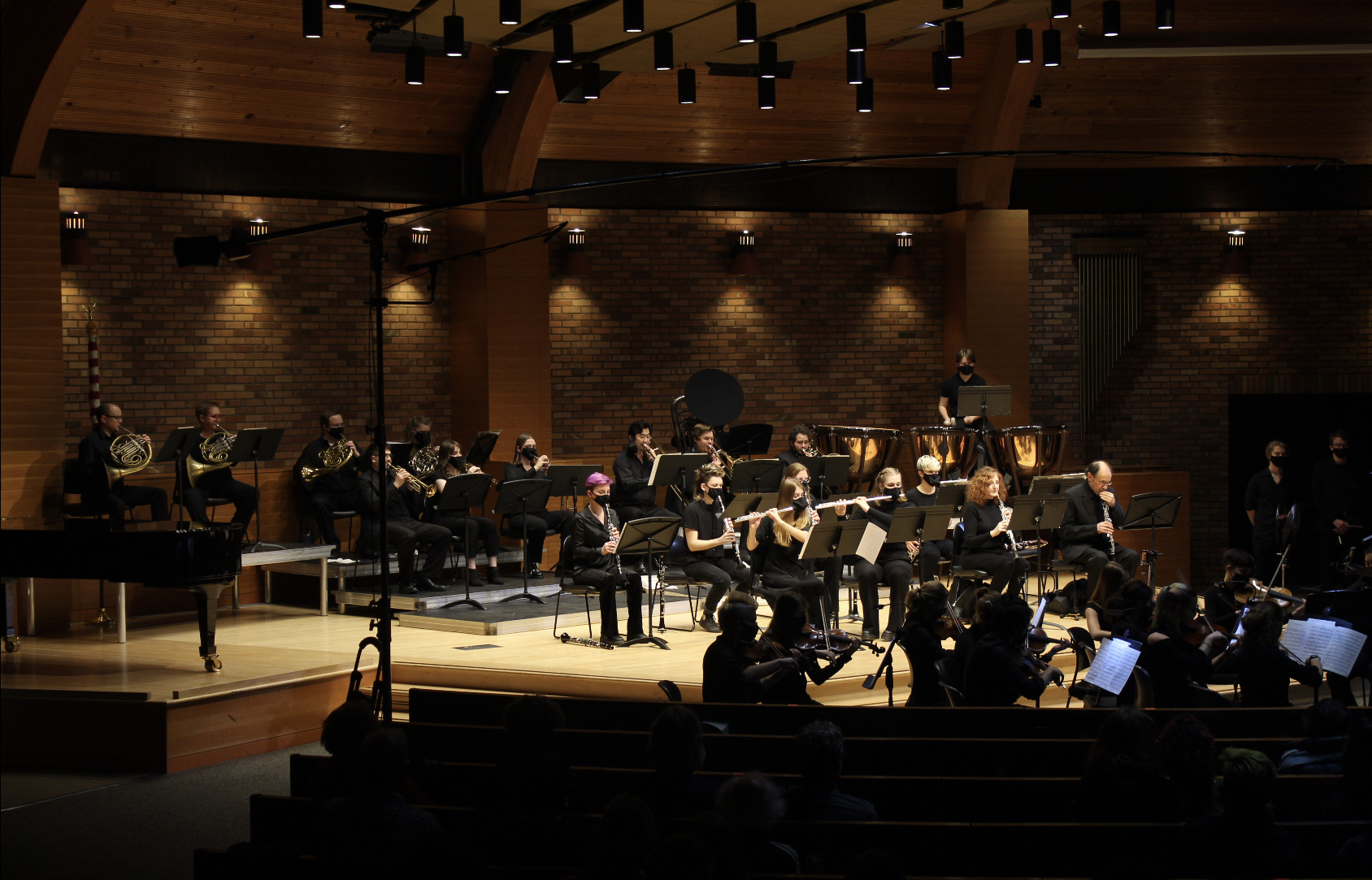
Dr. Robert Whalen, interim director and conductor of the Lewis & Clark Orchestra, turns to address the audience in Agnes Flanagan Chapel. It is the first time a director has done so since the outbreak of the COVID-19 pandemic.
“I had to start with the music, but I had to follow with welcome back,” Whalen said.
It is Oct. 24th at 7:45pm. The Lewis & Clark Orchestra has just completed their first piece of the night, “Finlandia,” from the 20th century composer Jean Sibelius. More than just the introduction to the fall concert, this rendition of “Finlandia” was the orchestra’s first “post-COVID” performance.
Ten minutes earlier, the Chapel had been bustling with noise and energy from the practicing orchestra along with the voices of students, faculty and parents who filled the venue. The orchestra and audience were both called to order with the arrival of Concertmaster Hannah Korn ’25. When she raised her violin to lead the orchestra in tuning, it was another first for the night.
“I’ve never played Concertmaster before,” Korn said. “We’ve been working so hard, I just want it to go well.”
After the driving performance of “Finlandia,” the orchestra moved on to their second piece of the night, a movement from Franz Schubert’s Symphony Number 8 “Unfinished.” The piece was led in by the woodwinds, then carried through its high moments by a powerful and resonant brass section, all the while being supported by the constant presence of the strings.
The level of coordination presented by the orchestra was all the more impressive considering the practice conditions imposed on them by the pandemic. At Thursday’s rehearsal, only four days prior, practice with the wind section had been limited to 50 minutes at a time, with the various instruments sequestered off into their own corners of Flanagan Chapel. Such restrictions presented a significant difficulty.
“It makes it very difficult, more for the winds than me.” Korn said. “You can’t rely on the audio cues you normally could if it was one big orchestra, you really have to tune into the conductor.”
For some students like first chair cellist Julia Scott ’25, however, the very opportunity to perform as a group was worth the restrictions.
“Last year we had to split our orchestra into very small groups.” Scott said. “It’s very nice to be able to meet with everyone.”
The crowning achievement of the night did not arrive until the third and final piece, which began with Whalen inviting Jack Waite ’23 to the stage. Waite performed on piano, with the orchestra’s backing, all three movements of Mozart’s “Concerto No. 23 in A Major.” It was the first time an LC orchestra had ever performed a concerto in its entirety, as Whalen was keen to remind the audience.
It was also a first for Jack Waite.
“This is my first time playing with an orchestra,” Waite said. “I’ve never played with more than one other person.”
Neither Waite nor the orchestra were without practice, however.
“I’ve been practicing this piece for over a year, the orchestra has been practicing it for about a month,” Waite said.
The practice did, of course, pay off. Waite’s dynamic piano carried the concerto through its three movements with stylistic ease. At times the accompanying orchestra seemed to raise the piano up on waves of sound, at others it faded away entirely, leaving Waite’s piano to stand on its own. When the final movement of the concerto came to its close, the orchestra was met with a rapturous standing ovation.
Beyond the music and applause, orchestra also means community and camaraderie for its members.
“Playing with other musicians is what some people might argue music is all about,” Korn said.
Scott shared a similar sentiment.
“You get to interact with a lot of people in a completely different way than you normally would,” Scott said. “It’s a lot of non-verbal communication and working together to create something beautiful; there’s really not anything else I do that’s quite like it.”
When discussing the dynamic within her cello section, Scott elaborated further about the sense of collectivity she feels.
“When you have your successes it’s either the entire section’s success or the entire section’s failure, it’s less individualistic,” Scott said.
In the case of this year’s fall concert, the success was clearly one for the whole orchestra to share. Not only did the orchestra demonstrate its resilient ability to withstand and return from the challenges of COVID-19, it also put a brave foot forward by embracing new challenges.
The LC Orchestra will continue into this year’s season with their next concert scheduled for Dec. 3. Times and information on other individual recitals and performances can be found on the Department of Music’s event calendar.
Subscribe to the Mossy Log Newsletter
Stay up to date with the goings-on at Lewis & Clark! Get the top stories or your favorite section delivered to your inbox whenever we release a new issue.

Leave a Reply